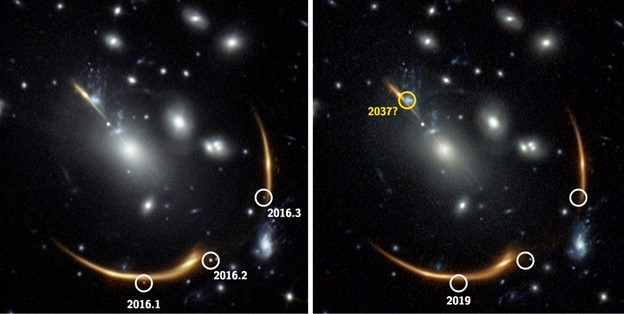Galactic repeat moves DAWN closer to the expansion of the universe
Scientists predict that a supernova will be seen for a fourth time in 2037, an event that may confirm researchers’ theory about gravity and bring them closer to an understanding of the expansion of the universe. The prediction of the supernova is part of a new study between the Danish National Research Foundation’s Cosmic Dawn Center (DAWN) at the Niels Bohr Institute at the University of Copenhagen and DTU Space as well as researchers from France and the US. The study was recently published in the scientific journal Nature Astronomy.

Because of the theory of relativity that, among other things, explains the staggered time in space, it was possible to observe the same galaxy at four different places in the sky. At the same, three different light sources were observed that turned out to be the same exploding star or, in other words, the supernova “SN-Requiem.” The observations come from a new study that was published in the scientific journal Nature Astronomy and is a collaboration between researchers from the DNRF’s Cosmic Dawn Center (DAWN) at the Niels Bohr Institute at the University of Copenhagen and DTU Space as well as researchers from the US and France.
“A single star exploded 10 billion years ago, long before even our own sun had formed, and the flash of light from that explosion has only just reached us. The fourth image of the galaxy is approximately 21 years behind those observed in 2016, and we should therefore see the supernova explode, once again, around the year 2037,” said Associate Professor Gabriel Brammer from DAWN, who is co-author on the study.
A potentially better understanding of the expansion of the universe awaits
The light from distant background galaxies may take different routes around the cluster, and since some of the routes are longer than others, it is possible to see images of the same light at different places in staggered time. If the supernova SN Requiem is seen again in 2037, a theory about gravity will be confirmed and this will take researchers a step closer to solving another mystery: the expansion of the universe. The observations come from the Hubble Space Telescope, which has an infrared wavelength region, and these data were later thoroughly analyzed.
“Understanding the structure of the universe is a top priority of the largest ground-based observatories and international space agencies over the next decade. Planned future surveys will cover a large fraction of the sky and are expected to reveal dozens or even hundreds of rare lensed supernovae like SN Requiem,” Brammer elaborated. “Precise time delay measurements from such sources provide unique and reliable tracers of the history of cosmic expansion that can help reveal the nature of dark matter and dark energy,” said Associate Professor Brammer.
Read the scientific article in Nature Astronomy here
Read more about the study at DAWN here
More information about the study at DR here
More information about the study at Politiken here
